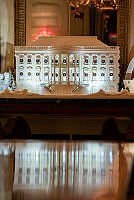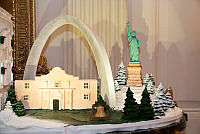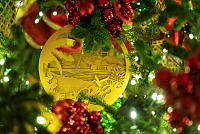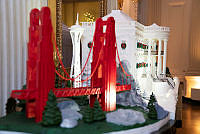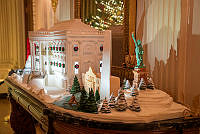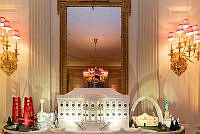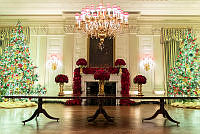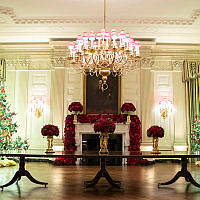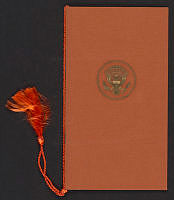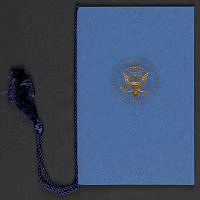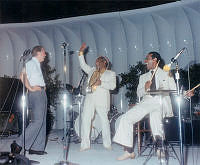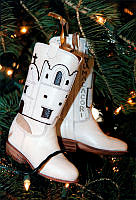Rubenstein Center Scholarship
The Truman Renovation Souvenir Program
As part of the implementation of the Truman renovation, the Commission on the Renovation of the Executive Mansion was tasked with disposing excess building materials that could not be reutilized. On February 17, 1950, President Truman approved the creation of a souvenir program. The leftover pieces in question were somewhat limited to materials that had “no tangible value but which were desired by many people for preservation as mementos or souvenirs of the historic building.”1

Sergeant at Fort Meyer, Virginia, selecting lumber from renovation of White House.
Abbie Rowe, National Park Service. Harry S. Truman Library & Museum.The Advisory Board on National Parks, Historic Sites, Buildings and Monuments advised the committee on which materials and objects were deemed historically significant and thus not be included in the distribution of materials. A conclusion was reached that “except for articles of considerable importance which ought to be held for future use at the White House, the surplus should be disposed of to governmental agencies, to appropriate non-governmental institutions and to patriotic organizations, groups, and individuals, who might desire the material for use or preservation.”2 More historically significant items and objects were given to museums across the country for public display. More practical items were given to government agencies.

Workers packing souvenir materials for distribution.
White House CollectionMaterials were categorized into four categories based on historic value and potential future use and display. Class I materials were classified as items that “retain their identities after removal . . . which have intrinsic as well as historical value.” Mantels within the Residence formed a large part of this category. Many were given to museums and cultural institutions across the country including the Denver Art Museum, Boston College, the Buffalo Historical Society in New York, the St. Louis Art Museum, and the Truman Library in Independence, Missouri.

Bronze authentication plate provided for each White House souvenir.
White House CollectionClass II surplus materials were defined as “usable building material of considerable practical value, including radiators, electrical equipment . . . with little or no sentimental value and not readily identifiable as coming from the White House.” Of items in this class were 10,000 bricks and 12 doors for construction at Fort Myer, Virginia, steel beams sent to the D.C. Department of Corrections, and 95,000 bricks that were sent to Mount Vernon for use in restorative projects at that location.
Class III items were “pieces of durable material, such as timbers, bricks, facing stones, and paneling, of some possible value for practical use, but of principal value on account of their association with the White House.” It was from these items that souvenir kits were packaged and disbursed. Although these kits were given free of charge, there was a shipping and handling fee.

Eight selections of souvenirs created from remnants of the White House renovation ordered by President Harry S. Truman.
White House CollectionLastly, Class IV materials were categorized as “disintegrated, broke, or perishable material.” These items were either buried in a dump at Fort Myer, Virginia, or, if combustible, burned in an incinerator. Beginning the next year, applications for materials could be sent to the souvenir programs office in Fort Myer, Virginia, across the Potomac River from Washington, D.C. Thirteen different “kits” were available for purchase, all consisting of various types of historic materials. For example, two dollars could buy enough pinewood for a gavel or cane. For the same amount, one could also purchase two pieces of stone for bookends. For one dollar, one could acquire a brick. Small metal plates confirming the kit’s authenticity accompanied these pieces.

Gavel Made from White House Wood.
White House Historical Association/White House CollectionDespite the stipulation that non-standard order requests from the public would not be met, several unique requests were nonetheless received at Fort Myer, including one man who wanted enough wood in order to carve a violin and one woman who requested a brick from the fireplace behind which President Franklin Roosevelt gave his favorite Fireside Chats.3

Bookends Fashioned from State Dining Room Brackets.
White House Historical Association/White House CollectionDemand for the smaller packages of excess nails, brick, wood, etc. exceeded initial expectations and receipts exceeded expenses by $10,000.4 Although the program has been long out of commission, one can argue these souvenirs, many of which still exist in homes and institutions across the country signify the continued importance of the White House and its symbolic resonance with the American people.5














